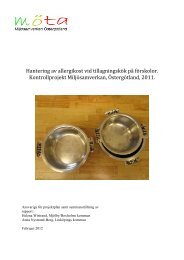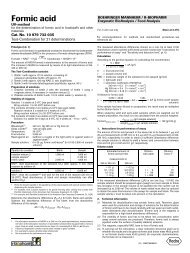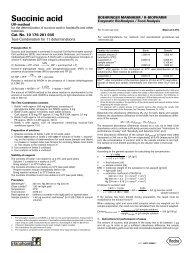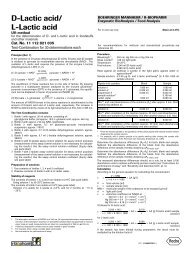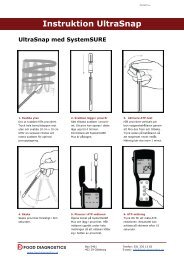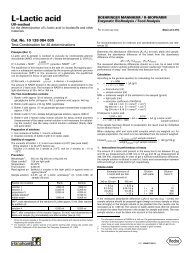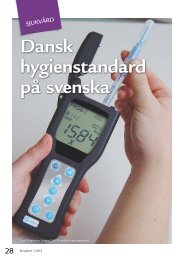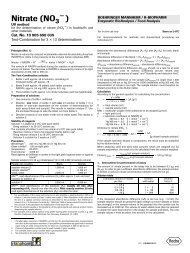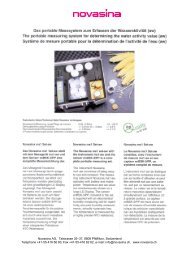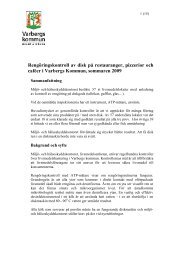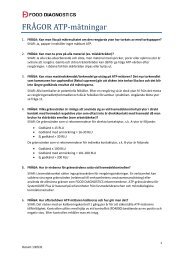Glycerol assay control solution - Food Diagnostics
Glycerol assay control solution - Food Diagnostics
Glycerol assay control solution - Food Diagnostics
You also want an ePaper? Increase the reach of your titles
YUMPU automatically turns print PDFs into web optimized ePapers that Google loves.
1. Instructions for performance of <strong>assay</strong>The glycerol content present in the <strong>assay</strong> has to be between 1 g and 40 g.In order to get a sufficient absorbance difference, the sample <strong>solution</strong> isdiluted to yield a glycerol concentration between 0.04 and 0.4 g/l.Dilution tableEstimated amount ofglycerol per liter 0.4 g0.4-4.0 g4.0-40 g 40 gDilutionwith water-1 + 91 + 991 + 999Dilutionfactor F1101001000If the measured absorbance difference (A) is too low (e.g. 0.100), thesample <strong>solution</strong> should be prepared again (weigh out more sample or diluteless strongly) or the sample volume to be pipetted into the cuvette can beincreased up to 2.000 ml. The volume of water added must then be reducedso as to obtain the same final volume in the <strong>assay</strong>s for sample and blank.The new sample volume v must be taken into account in the calculation.2. Technical informationIt is necessary to wait for the completion of the pre-reaction after the additionof suspension 2 (PK/L-LDH).3. Specificity (Ref. 1)The method is specific for glycerol. Dihydroxyacetone is not converted underthe given conditions.In the analysis of commercial glycerol results of approx. 100% (calculated onthe water-free substance) have to be expected.4. Sensitivity and detection limitThe smallest differentiating absorbance for the procedure is 0.005 absorbanceunits. This corresponds to a maximum sample volume v = 2.000 ml andmeasurement at 340 of a glycerol concentration of 0.1 mg/l sample <strong>solution</strong>(if v = 0.100 ml, this corresponds to 2 mg/l sample <strong>solution</strong>).The detection limit of 0.4 mg/l is derived from the absorbance difference of0.020 (as measured at 340 nm) and a maximum sample volume v = 2.000 ml.5. LinearityLinearity of the determination exists from approx. 1 g glycerol/<strong>assay</strong>(0.4 mg glycerol/l sample <strong>solution</strong>; sample volume v = 2.000 ml) to 40 gglycerol/<strong>assay</strong> (0.4 g glycerol/l sample <strong>solution</strong>; sample volume v =0.100 ml).6. PrecisionIn a double determination using one sample <strong>solution</strong>, a difference of 0.005 to0.010 absorbance units may occur. With a sample volume of v = 0.100 mland measurement at 340 nm, this corresponds to a glycerol concentration ofapprox. 2-5 mg/l. (If the sample is diluted during sample preparation, theresult has to be multiplied by the dilution factor F. If the sample is weighed infor sample preparation, e.g. using 1 g sample/100 ml = 10 g/l, a difference of0.02-0.05 g/100 g can be expected.)The following data have been published in the literature:CV = 2.5 % in series serumCV = 2.59 % from day to day serum (Ref. 1.2)Pastilles m = 1.482 g/100 g r = 0.0393 g/100/g R = 0.1484 g/100 gStandard m = 0.206 g/l r = 0.0047 g/l R = 0.0115 g/lWhite grape juice m = 0.613 g/l r = 0.0138 g/l R = 0.0337 g/lRed grape juice m = 0.907 g/l r = 0.0251 g/l R = 0.0511 g/lWhite wine m = 6.050 g/l r = 0.1154 g/l R = 0.5002 g/lRed wine m = 16.57 g/l r = 0.3166 g/l R = 1.1240 g/l(Ref. 3.8)7. Interference/sources of errorThe slow hydrolysis of ATP and phosphoenolpyruvate as well as the air oxidationof NADH results in a slow creep reaction which can be taken intoaccount by extrapolation. An extrapolation is not absolutely necessary if theabsorbances of blank and sample are measured immediately one afteranother.8. Recognizing interference during the <strong>assay</strong> procedure8.1 If the conversion of glycerol has been completed according to the timegiven under “Procedure“ it can be concluded in general that no interferencehas occurred.8.2 On completion of the reaction, the determination can be restarted byadding glycerol (qualitative or quantitative): if the absorbance is alteredsubsequent to the addition of the standard material, this is also anindication that no interference has occurred.8.3 Operator error or interference of the determination through the presenceof substances contained in the sample can be recognized by carryingout a double determination using two different sample volumes (e.g.0.100 ml and 0.200 ml): the measured differences in absorbance shouldbe proportional to the sample volumes used.When analyzing solid samples, it is recommended that differentquantities (e.g. 1 g and 2 g) be weighed into 100 ml volumetric flasks.The absorbance differences measured and the weights of sample usedshould be proportional for identical sample volumes.8.4 Possible interference caused by substances contained in the sample canbe recognized by using an internal standard as a <strong>control</strong>: in addition tothe sample, blank and standard determinations, a further determinationshould be carried out with sample and <strong>assay</strong> <strong>control</strong> <strong>solution</strong> in thesame <strong>assay</strong>. The recovery can then be calculated from the absorbancedifferences measured.8.5 Possible losses during the determination can be recognized by carryingout recovery tests: the sample should be prepared and analyzed withand without added standard material. The additive should be recoveredquantitatively within the error range of the method.9. Reagent hazardThe reagents used in the determination of glycerol contain hazardous materialsin the sense of the Hazardous Substances Regulations, the ChemicalsLaw or EC Regulations 67/548 and 99/45 and subsequent alteration, supplementationand adaptation guidelines. Please refer to the safety date sheet orthe labels of the affected vials for further information.10. General information on sample preparationIn carrying out the <strong>assay</strong>:Use clear, colorless and practically neutral liquid samples directly, orafter dilution according to the dilution table, and of a volume up to 2.000 ml;Filter turbid <strong>solution</strong>s;Degas samples containing carbon dioxide (e.g. by filtration);Adjust acid samples to approx. pH 8 by adding sodium or potassiumhydroxide <strong>solution</strong>;Adjust acid and weakly colored samples to approx. pH 8 by addingsodium or potassium hydroxide <strong>solution</strong> and incubate for approx. 15 min;Treat “strongly colored“ samples that are used undiluted or with a highersample volume with polyvinylpolypyrrolidone (PVPP) or with polyamide, e.g.1g/100 ml;Crush or homogenize solid or semi-solid samples, extract with water ordissolve in water and filter if necessary; resp. remove turbidities or dyestuffsby Carrez clarification;Deproteinize samples containing protein with Carrez reagents;Extract samples containing fat with hot water (extraction temperatureshould be above the melting point of the fat involved). Cool to allow the fatto separate, make up to the mark, place the volumetric flask in an ice bathfor 15 min and filter; alternatively clarify with Carrez-<strong>solution</strong>s after theextraction with hot water.Carrez clarification:Pipette the liquid sample into a 100 ml volumetric flask which containsapprox. 60 ml redist.water, or weigh sufficient quantity of the sample into a100 ml volumetric flask and add approx. 60 ml redist. water. Subsequently,carefully add 5 ml Carrez-I-<strong>solution</strong> (potassium hexacyanoferrate(II) (ferrocyanide),85 mM = 3.60 g K 4 [Fe(CN) 6 ] × 3 H 2 O/100 ml) and 5 ml Carrez-II<strong>solution</strong>(zinc sulfate, 250 mM = 7.20 g ZnSO 4 × 7 H 2 O/100 ml). Adjust to pH7.5-8.5 with sodium hydroxide (0.1 M; e.g. 10 ml). Mix after each addition. Fillthe volumetric flask to the mark, mix and filter.2



